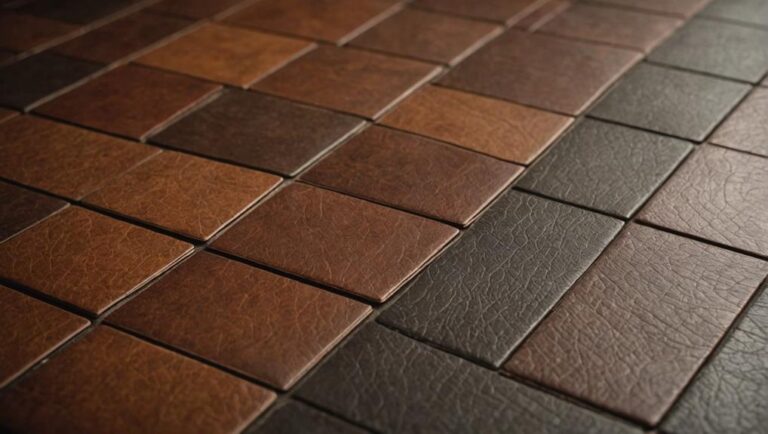To clean your outdoor tile floors effectively, start by identifying the tile type. Gather supplies like a broom, mop, scrub brush, and eco-friendly cleaners such as vinegar and baking soda. Before cleaning, remove loose debris and inspect for any damage. For regular maintenance, sweep often and pressure wash stubborn grime when needed, ensuring you use low pressure. Allow cleaning solutions to sit before scrubbing, and always rinse thoroughly. To prevent future build-up, seal tiles regularly and maintain a cleaning schedule. Interested in elevating your outdoor cleaning routine even further? There's more to explore!
Assessing Your Tile Type
When evaluating your tile type, start by identifying the material your tiles are made from. This is essential because different materials exhibit varying levels of tile durability, especially under outdoor conditions. Common materials include ceramic, porcelain, and natural stone. Each has its own strengths and weaknesses, impacting how well they withstand the elements.
Ceramic tiles are often a popular choice for outdoor settings due to their affordability and variety. However, you should confirm they're rated for outdoor use, as not all ceramic tiles are built to endure freeze-thaw cycles or high moisture levels. Porcelain tiles, on the other hand, are denser and less porous, making them highly durable and resistant to water. This makes them an excellent option for areas that experience heavy rainfall or temperature fluctuations.
Natural stone tiles, such as slate or granite, offer a unique aesthetic but may require additional maintenance. They can be more susceptible to staining and might need sealing to enhance their durability against outdoor conditions. Regardless of the material, it's important to check for slip resistance, especially if your outdoor area can get wet. Safety should always be a priority, as slips and falls can lead to serious injuries.
Gathering Necessary Supplies
Before you start cleaning your outdoor tile floors, it's important to gather the right supplies. You'll need essential cleaning tools like a broom, mop, and scrub brush, along with recommended cleaning solutions tailored for your tile type. Having everything ready will make the process smoother and more effective.
Essential Cleaning Tools
Having the right tools at your disposal can make all the difference when it comes to cleaning outdoor tile floors effectively. First, gather a broom or a leaf blower to remove loose dirt and debris. This step is vital for maintaining cleanliness and should be done regularly, depending on your outdoor maintenance needs.
Next, invest in a sturdy mop with a microfiber pad. This type of mop is great for reaching into the grout lines and capturing dirt without scratching the tile. You'll also need a bucket for mixing cleaning solutions safely. Be certain to use a long-handled brush for tougher stains; this way, you can scrub without bending too much, which can help prevent back strain.
A pressure washer can be a valuable tool, especially if you've got stubborn grime, but be cautious with the pressure settings to avoid damaging your tiles. Finally, don't forget rubber gloves to protect your hands while cleaning. By equipping yourself with these essential tools, you'll streamline your cleaning frequency and guarantee your outdoor tile floors stay in great shape year-round.
Recommended Cleaning Solutions
To guarantee your outdoor tile floors remain spotless, you'll need to gather the right cleaning solutions tailored to the type of tiles you have. Start by considering natural cleaners, which are often safer for both your tiles and the environment. A simple mixture of vinegar and water can effectively cut through grime without harsh chemicals. For tougher stains, baking soda combined with water creates a paste that can be gently scrubbed onto the affected area.
However, if you find that natural methods aren't quite cutting it, there are several commercial solutions available. Look for pH-balanced cleaners specifically designed for outdoor tiles. These solutions are formulated to lift dirt while protecting the surface from damage. Always check the label to verify it's safe for your tile type and follow the manufacturer's instructions for best results.
Regardless of which cleaning solution you choose, it's crucial to test a small, inconspicuous area first. This way, you can be sure your chosen cleaner won't harm the tile. With the right supplies in hand, you'll be well on your way to maintaining beautiful, clean outdoor tile floors.
Pre-Cleaning Preparation
Before you start cleaning your outdoor tile floors, it's important to get everything in order. First, make certain you've gathered all necessary supplies and inspect the tile condition to identify any issues. Finally, remove any loose debris to guarantee a smooth cleaning process.
Gather Necessary Supplies
Gathering the right supplies is essential for effectively cleaning outdoor tile floors. To tackle this task safely and efficiently, you'll need a few key items. Start with a broom or outdoor vacuum to remove loose dirt and debris. This step is vital, especially if your tiles are exposed to varying outdoor conditions like rain or leaves, which can accumulate quickly.
Next, you'll want a sturdy mop and a bucket for your cleaning solution. Depending on your cleaning frequency—weekly or monthly—you might choose a mild detergent or a specialized tile cleaner that's safe for outdoor use. Always check the label for any safety warnings or recommendations.
Don't forget a pair of gloves to protect your hands from harsh chemicals, and consider using safety goggles if you're using any strong cleaning agents. Finally, a scrub brush with stiff bristles will help you tackle tough stains without damaging your tiles.
Inspect Tile Condition
Once you've gathered all your supplies, it's time to inspect the condition of your outdoor tiles. This step is essential for guaranteeing the longevity of your tiles and preventing further damage during the cleaning process. Take a close look at each tile and note any cracks, chips, or loose pieces. Addressing these issues beforehand can save you time and money in the long run.
Here's a quick guide to help you identify tile conditions:
| Condition | Action Needed |
|---|---|
| Cracked Tiles | Consider replacing them to avoid further damage. |
| Chipped Tiles | Fill in chips with a suitable filler for aesthetics. |
| Loose Tiles | Reseal or reattach to guarantee safety and stability. |
| Stained Tiles | Use appropriate cleaning solutions for stains. |
Remove Loose Debris
Cleaning outdoor tile floors starts with an essential step: removing loose debris. Before diving into any cleaning solution, take a few moments to clear away dirt, leaves, and other clutter that can hinder the effectiveness of your outdoor cleaning efforts. Not only does this help maintain the aesthetic appeal of your space, but it also guarantees safety by reducing slip hazards.
Begin by using a broom or a leaf blower to sweep away any loose particles. Pay special attention to corners and areas where dirt tends to accumulate. If you notice any larger debris, like sticks or stones, pick those up by hand to prevent damage to your tiles during the cleaning process.
Once the loose debris is cleared, you'll find that your outdoor cleaning task becomes much more manageable. This simple step facilitates better tile upkeep, allowing cleaning solutions to work more effectively and guaranteeing that any stubborn stains or grime don't get pushed around. Remember, a clean surface is not only more aesthetically pleasing but also a safer environment for you and your guests. So, take a moment to prepare your tiles properly before moving on to the next cleaning steps.
Effective Cleaning Techniques
Regularly maintaining your outdoor tile floors can make a significant difference in their appearance and longevity. To keep them looking their best, you'll want to adopt effective cleaning techniques that are both safe and efficient. Start by using a broom or blower to remove loose debris. This simple step prevents dirt from becoming embedded in the tile or grout.
For a deeper clean, consider eco-friendly options like vinegar and baking soda. Mix equal parts of vinegar and water in a spray bottle, then spray it onto the tiles. Allow it to sit for a few minutes to break down grime before scrubbing with a soft-bristled brush. Baking soda can also be sprinkled directly on tough spots, providing gentle abrasion without damaging the surface.
If your tiles need more than just a basic clean, pressure washing can be an excellent option. It effectively removes dirt, mold, and mildew without the need for harsh chemicals. Just be sure to use a low-pressure setting to avoid damaging the tiles or grout. Always wear safety goggles and make sure to follow the manufacturer's instructions for your pressure washer.
Dealing With Stains
When it comes to outdoor tile floors, stains can be a persistent nuisance, but tackling them doesn't have to be overwhelming. Knowing the common stain types you'll encounter—like oil, food, rust, or mold—can help you choose the right stain removal techniques to get your tiles looking fresh again.
For oil stains, a mixture of baking soda and water works wonders. Apply it to the stain, let it sit for about 30 minutes, then scrub gently with a soft brush. Rinse with water to avoid any residue. Food stains can often be treated with a simple solution of warm water and dish soap. Just scrub the area with a cloth or sponge, then rinse well.
Rust stains are a bit trickier, but you can use a commercial rust remover that's safe for tiles. Always follow the manufacturer's instructions and wear gloves for protection. Mold and mildew require a mixture of vinegar and water. Spray it on the affected area, let it sit for about 10 minutes, and then scrub with a brush before rinsing.
Regardless of the stain type, always test your cleaning solution on a small, inconspicuous area first to verify it won't damage the tile. Keeping your outdoor tile floors clean and stain-free not only enhances their appearance but also helps prolong their lifespan. With these strategies in hand, you can confidently handle any stains that come your way.
Preventing Future Build-Up
To keep your outdoor tile floors looking their best, it's vital to take proactive steps to prevent future build-up of dirt and grime. One of the most effective measures is regular sealing of your tiles. By applying a high-quality sealant, you create a protective barrier that helps resist stains, dirt, and moisture, greatly reducing the likelihood of build-up over time. Be sure to choose a sealant suitable for outdoor use and follow the manufacturer's instructions for application.
Another key aspect of maintaining your outdoor tiles is mold prevention. Mold thrives in damp environments, so it's important to confirm your tiles are well-ventilated and dry. After rainy days or heavy watering, make it a habit to wipe down the tiles or use a leaf blower to remove any standing water. This simple action can greatly reduce moisture accumulation and deter mold growth.
Additionally, consider implementing a regular cleaning schedule. Sweeping or hosing down your outdoor tiles weekly can help keep loose dirt and debris at bay. If you notice any stubborn spots, address them promptly before they have a chance to set in.
Lastly, be mindful of any plants or landscaping around your outdoor tiles. Trim back overgrown vegetation that may trap moisture against your tiles, creating a perfect environment for mold and grime. By taking these preventive measures, you'll maintain the beauty and safety of your outdoor tile floors for years to come.
Seasonal Maintenance Tips
Maintaining your outdoor tile floors goes beyond just preventive measures; seasonal maintenance plays a significant role in keeping them in top shape. As the seasons change, so do the weather impacts on your tiles. Each season brings unique challenges that can affect the longevity and appearance of your outdoor surfaces.
In spring, it's essential to clear away debris and check for any damage that may have occurred over winter. Look for cracks or loose tiles that could lead to bigger issues later. A thorough cleaning with mild detergent and water will help remove any grime accumulated during the colder months.
Summer brings intense heat and, often, increased foot traffic. Regularly sweep or hose down your tiles to prevent dirt and sand buildup, which can scratch surfaces and create slip hazards. Consider applying a sealant to protect against UV damage and fading.
As autumn arrives, leaves can become a nuisance. Make sure to regularly remove fallen leaves, as they can trap moisture and promote mold growth. It's also a good time to inspect and clean your grout lines to prevent staining.
Frequently Asked Questions
Can I Use a Pressure Washer on Outdoor Tile Floors?
You can use a pressure washer on outdoor tile floors, but it's important to take certain precautions. The benefits of a pressure washer include effectively removing dirt and grime, making your tiles look fresh. However, you should avoid using too high a pressure, as it might damage the tiles or grout. Always start at a lower setting, and maintain a safe distance to guarantee you're cleaning safely without causing harm.
How Often Should I Clean My Outdoor Tile Floors?
Did you know that regular cleaning can extend the lifespan of your outdoor tiles by up to 50%? To keep them looking their best, aim for a cleaning frequency of at least once every season. This seasonal maintenance helps prevent dirt and grime buildup, making it safer for you and your guests. If you live in a particularly dusty area or have heavy foot traffic, consider increasing that frequency for ideal results!
Is Vinegar Safe for All Tile Types?
While vinegar is often praised for its cleaning properties, it's not safe for all tile types. For instance, acidic substances like vinegar can damage natural stone tiles. If you're concerned about tile maintenance, consider vinegar alternatives like mild dish soap and water or specialized tile cleaners. Always check the manufacturer's recommendations for your specific tiles to guarantee you're using safe cleaning methods that won't harm their surface or finish. Stay safe while keeping your tiles clean!
What Should I Do if My Tile Gets Slippery?
If your tile gets slippery, it's vital to take action for safety. You can start by using slippery surface solutions like mats or rugs to provide traction. Additionally, consider applying anti-slip treatments specifically designed for tile. These treatments can enhance grip without altering your tile's appearance. Regularly cleaning your tiles can also help prevent buildup that contributes to slipperiness. Prioritizing safety in your space is essential, so don't hesitate to make these changes!
Can I Seal My Outdoor Tiles After Cleaning?
If you've just cleaned your outdoor tiles, it's time to seal the deal! Yes, you can seal your outdoor tiles after cleaning. Just make sure they're completely dry before applying any sealing options. Choose a high-quality sealer that's compatible with your tiles and safe for outdoor use. Be cautious with cleaning products; some can interfere with the sealing process. Sealing not only enhances appearance but also offers protection against slips and stains.




